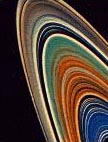
| Bad Astronomy |
|
|
|
BA Blog
|
|
Q & BA
|
|
Bulletin Board
|
| Media |
|
|
|
Bitesize Astronomy
|
|
Bad Astro Store
|
|
Mad Science
|
|
Fun Stuff
|
| Site Info |
|
|
|
Links
|
| RELATED SITES |
| - Universe Today |
| - APOD |
| - The Nine Planets |
| - Mystery Investigators |
| - Slacker Astronomy |
| - Skepticality |
Buy My Stuff

Keep Bad Astronomy close to your heart, and help make me
filthy rich. Hey, it's either this or one of those really
irritating PayPal donation buttons here.
Gaps in Saturn's Rings
Week of March 10, 1997 Have you ever looked at pictures of Saturn's rings and
noticed what look like gaps in the rings? You're not the
first! Gian Domenico Cassini discovered a large gap
in Saturn's rings in 1675. Later, an astronomer named
Encke discovered a smaller gap near the edge of the rings.
Have you ever looked at pictures of Saturn's rings and
noticed what look like gaps in the rings? You're not the
first! Gian Domenico Cassini discovered a large gap
in Saturn's rings in 1675. Later, an astronomer named
Encke discovered a smaller gap near the edge of the rings.
 What causes these gaps? Well, the rings are not solid, but composed
of a vast number of tiny particles, most of which are plain
old water ice. These chunks of ice are very small; most are probably
only centimeters across! Each chunk orbits Saturn individually, like
a swarm of billions of moons. It was found long ago that an orbit in
the Cassini Division, as the large gap is named, has a period almost exactly
one-half that of one of Saturn's moons named Mimas. This means that
every other time a chunk of ice orbits Saturn in the Cassini Division, it would
see Mimas in the same position in the sky. Mimas has a pretty good mass, which
means it has substantial gravity. Over millions of years, this periodic tug has
yanked all the particles out of that region in Saturn's rings.
What causes these gaps? Well, the rings are not solid, but composed
of a vast number of tiny particles, most of which are plain
old water ice. These chunks of ice are very small; most are probably
only centimeters across! Each chunk orbits Saturn individually, like
a swarm of billions of moons. It was found long ago that an orbit in
the Cassini Division, as the large gap is named, has a period almost exactly
one-half that of one of Saturn's moons named Mimas. This means that
every other time a chunk of ice orbits Saturn in the Cassini Division, it would
see Mimas in the same position in the sky. Mimas has a pretty good mass, which
means it has substantial gravity. Over millions of years, this periodic tug has
yanked all the particles out of that region in Saturn's rings.
The Encke division, on the other hand, is the result of a direct sweeping of a small satellite located inside the gap. It actually pulls particles out of its way as it orbits Saturn, leaving a gap in the rings!
I remember when I was a kid, thinking about Mimas clearing a gap. I thought to myself, "What if a particle has an orbit one-third of Mimas' period? Would it get cleaned out too? How about one-fifth, or tenth?" Oh, how I wish I had asked a professional astronomer! When the Voyager probes went to Saturn, they discovered that the main rings of Saturn are actually divided into thousands of tiny ringlets! I could have been famous! Oh well. Who wants to have something named after them that isn't there?
If you are ever looking for info on anything in the solar system, you should always start at Bill Arnett's Nine Planets site.
An excellent summary of science done by the Voyager missions can be found courtesy of the Jet Propulsion Laboratory.
More good Saturn ring information can be found at the National Air and Space Museum's Saturn page.
|
|
| THE PANTRY: ARCHIVE OF BITESIZE SNACKS |
|
|
| Subscribe to the Bad Astronomy Newsletter! |
| Talk about Bad Astronomy on the BA Bulletin Board! |